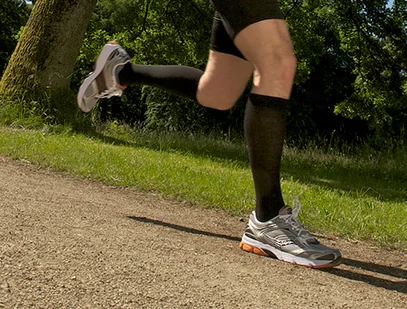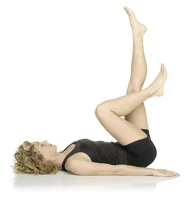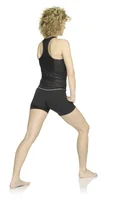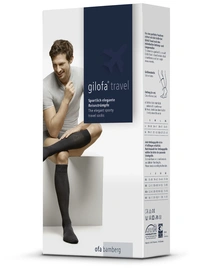Movement Exercises
Movement is good for you!
The causes of vein disorders are manifold. They range from inherited or age-related weakness of the connective tissue to hormonal changes (e.g. birth control pills, pregnancy, menopause) as well as intensive sun exposure or restrictive clothing. Alcohol, smoking, lack of exercise and excess weight are additional risk factors.
If you wish to prevent vein disorders, maintaining a healthy lifestyle can do a lot for the health of your veins. A balanced diet is just as important as exercise.
Even for those who already suffer from vein disorders, movement exercises are a crucial component and absolutely essential for successful therapy. Regular exercise is crucial for supporting blood transport from the leg veins to the heart. In addition to sufficient exercise, all kinds of sports that keep the joints flexible and activate the muscles in the legs are also recommended.
Vein gymnastics stimulate blood flow
Special exercises as part of so-called vein gymnastics actively help promote vein health.
Tip: Wear loose and comfortable clothing. Schedule at least ten minutes twice a day for the exercises and do them barefoot.

-
 1. Warm up. Always start with a warm-up phase while lying on your back: Perform a "cycling" movement for approximately 30 seconds.
1. Warm up. Always start with a warm-up phase while lying on your back: Perform a "cycling" movement for approximately 30 seconds. -
 2. Stretch. Standing up, stretch your leg and hold the tension in the calf for about 15 seconds. Switch legs. Repeat five times.
2. Stretch. Standing up, stretch your leg and hold the tension in the calf for about 15 seconds. Switch legs. Repeat five times. -
 3. While sitting down, alternate between lifting and lowering your heels. Repeat 15 - 20 times. By the way, the "rolling" exercise can be done anywhere (in the office, bus or car, while watching TV, etc.) throughout the day.
3. While sitting down, alternate between lifting and lowering your heels. Repeat 15 - 20 times. By the way, the "rolling" exercise can be done anywhere (in the office, bus or car, while watching TV, etc.) throughout the day. -
 4. Stork walk. Alternately raise your knees to a right angle. Then lift the heel of the standing leg. Repeat 15 - 20 times.
4. Stork walk. Alternately raise your knees to a right angle. Then lift the heel of the standing leg. Repeat 15 - 20 times.
Vein walking - to keep things running smoothly
The popular sport of Nordic walking is also a particularly good choice. This modern form of running is a sport that specifically targets the veins. Healthy, intensive walking activates the muscle pump. This stimulates the venous return of blood to the heart in a natural way, without overloading the organism or the venous system. This type of normal, slightly faster walking has the advantage of being equally suitable for people of all ages.
The right walking technique
Tip: Try to find your rhythm and stay relaxed. Nordic walking courses are offered by physiotherapists and fitness and health studios.
1. Start off at a slow pace.
2. With slightly bent knees, always put your heels down first.
3. Then roll your feet down over the soles.
4. Place your toes in the walking direction.
5. Bend your arms and let them swing sideways next to your body.
6. Swing arms in opposite directions.
7. Consciously breathe in and out deeply at regular intervals.
8. Keep your gaze about four to five meters ahead.
9. Let your shoulders hang loosely.
10. Lift your chest.
The medically correct pressure curve improves blood circulation, which will boost your energy levels and stimulates oxygen supply to the muscles.

Our tips ...
Comfortable and loose clothing: Ensures that blood can flow freely. Skin-tight jeans, on the other hand, can constrict the veins, especially in the groin area.
Flat and comfortable shoes: Good for your ankle pump and helps the veins transport blood from the legs to the heart.
Walking barefoot: Promotes blood circulation.
Don't cross your legs: This can compress the saphenous veins in the groin and interrupt the blood flow.
Stairs instead of elevators: Keeps your veins fit and boosts your circulation!
Healthy and balanced diet: Being overweight promotes vein problems and should therefore be avoided.
Drink plenty of fluids: Supports blood circulation.
Elevate your legs: Makes it easier for the veins to transport blood from the legs to the heart.
... and how they can help!
Use a footrest/bench at your workplace: Anyone who sits for long periods of time should elevate their feet at regular intervals.
Cool leg showers: Invigorates your legs in the morning and evening.
Avoid intense heat! Sunbathing as well as hot baths, showers or saunas should be avoided. Alternatively, you should cool your legs sufficiently after a sauna session!
Support stockings as a preventive measure: If you stand or sit a lot, support stockings (e.g. Gilofa) can prevent vein problems.
Wear travel stockings: On long flights or car journeys, even persons with healthy veins should wear special travel stockings (e.g. Gilofa® 2000) to prevent travel thrombosis.
Take regular breaks: During long car journeys, take a break every two hours to move your legs.






